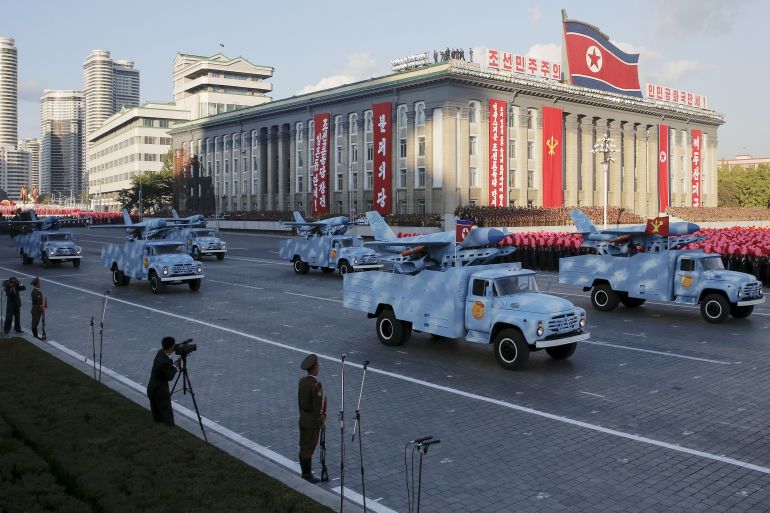Why are North Korea’s drones spooking the South?
South Korea’s military failed to shoot down five drones on Monday, sparking national concern amid rising tensions.

North Korean drones entered South Korean airspace on Monday for the first time since 2017 in the latest example of escalating tensions between the neighbouring countries.
The South’s military was caught off guard, drawing criticism on Tuesday from President Yoon Suk-yeol, who sought to assuage concerns by announcing his cabinet would fast-track plans for a special drone unit.
Keep reading
list of 2 itemsSouth Korea fires shots, sends jets after invading North drones
What happened yesterday?
- What: Five North Korean drones crossed into South Korea on Monday, prompting Seoul to scramble fighter jets and attack helicopters to try and shoot them down.
- When: The drones were first detected in South Korea at 10:25am (01:25 GMT)
- Where: The drones were first spotted over the northwestern city of Gimpo but flew over multiple South Korean cities, including the capital, Seoul.
South Korea’s military fired warning shots and some 100 rounds from a helicopter equipped with a machine gun but failed to bring down any of the drones.
The military said it chased one of the five drones over the greater Seoul area but did not fully aggressively engage with it out of concern for civilian safety.
A defence ministry official confirmed a South Korean KA-1 fighter jet was involved in an accident while flying to counter North Korea’s drones after departing its Wonju base in the country’s north. Its two pilots escaped before the crash and were treated in a hospital.
What has the reaction been in South Korea?
President Yoon expressed concern on Tuesday at the military’s inability to bring down the drones at a time when the country is looking to combat the North’s evolving nuclear and missile threats.
“The incident showed a substantial lack of our military’s preparedness and training for the past several years and clearly confirmed the need for more intense readiness and training,” Yoon told a cabinet meeting.
South Korea’s military later apologised for failing to shoot down the North Korean drones.
“The incident caught the South’s military off guard, exposing the immaturity of its responses,” said Cha Du-hyeogn, a senior fellow at the Asan Institute for Policy Studies in Seoul. “They will need to check their GPS jamming and overall response systems.”
The president said the country would create a military unit specialising in drones in response to Monday’s incursion.
Yoon blamed the lack of preparedness on his predecessor Moon Jae-in’s “dangerous” North Korea policy, which relied on Pyongyang’s “good intentions” and a 2018 inter-Korean military pact banning hostile activities in the border areas.
“We have been planning to establish a drone unit to monitor and reconnoitre major North Korean military facilities and will now expedite the plan as much as possible,” he added, promising to boost its surveillance and reconnaissance capability with cutting-edge stealthy drones.
But the opposition Democratic Party, which Moon represented, criticised the Yoon government over its failure to shoot down the drones.
What is the background to this incident?
The incident was the latest airspace intrusion by unmanned aerial vehicles from the isolated North, with the two Koreas remaining technically at war after their 1950-53 war ended in an armistice, not a peace treaty.
In 2014, a North Korean drone was discovered on a South Korean border island, but its design and capabilities were not deemed sophisticated by the South Korean authorities.
In 2017 a drone believed to be on a spy mission crashed and was found on a mountain near the border. This device boasted superior capabilities to the 2014 drone with double the engine capacity and battery power.
Yesterday’s incident is believed to be the first time a North Korean drone has entered South Korean airspace since the 2018 inter-Korean military pact.
The Joint Chiefs of Staff said the latest drones were similarly sized to the 2017 spy drone, measuring about two metres, but it was unclear whether they are more technically advanced.
Analysts said the drones might be too small and primitive to conduct full reconnaissance missions, but they could be enough to carry a weapon or disrupt aviation activity. Several commercial flights at Incheon and Gimpo airports were grounded for about 50 minutes at the request of the South Korean military on Monday.
Pyongyang has been flexing its military might in recent weeks, test-firing a barrage of missiles that have sparked concern in South Korea, Japan and among their Western allies.
North Korea had also fired two short-range ballistic missiles on Friday after a joint air drill by South Korea and the United States a few days earlier.
North Korea has also tested a high-thrust solid-fuel engine that experts said would allow a quicker and more mobile launch of ballistic missiles.
What drone capabilities does North Korea have?
A 2016 report by United Nations sanctions monitors said North Korea owns about 300 drones of various types, including for reconnaissance, target practice and combat.
The monitor noted that the drones recovered in the South used parts imported from China, the Czech Republic, Japan, Switzerland and the United States.
North Korean leader Kim Jong Un has publicly shown interest in drones and pledged at a meeting of the ruling Workers’ Party last year to develop new reconnaissance drones capable of flying up to 500km (311 miles).